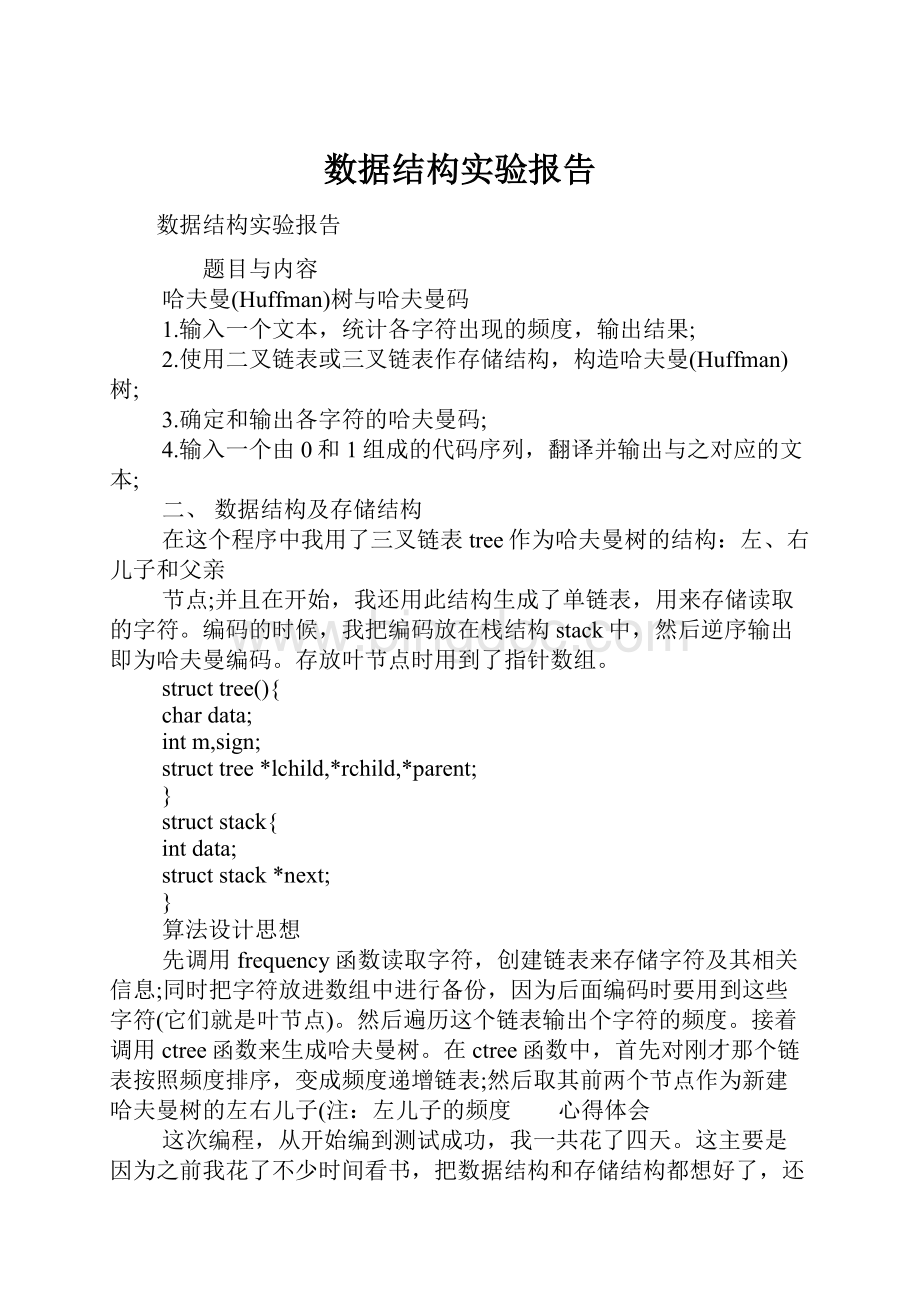数据结构实验报告.docx
《数据结构实验报告.docx》由会员分享,可在线阅读,更多相关《数据结构实验报告.docx(8页珍藏版)》请在冰点文库上搜索。

数据结构实验报告
数据结构实验报告
题目与内容
哈夫曼(Huffman)树与哈夫曼码
1.输入一个文本,统计各字符出现的频度,输出结果;
2.使用二叉链表或三叉链表作存储结构,构造哈夫曼(Huffman)树;
3.确定和输出各字符的哈夫曼码;
4.输入一个由0和1组成的代码序列,翻译并输出与之对应的文本;
二、数据结构及存储结构
在这个程序中我用了三叉链表tree作为哈夫曼树的结构:
左、右儿子和父亲
节点;并且在开始,我还用此结构生成了单链表,用来存储读取的字符。
编码的时候,我把编码放在栈结构stack中,然后逆序输出即为哈夫曼编码。
存放叶节点时用到了指针数组。
structtree(){
chardata;
intm,sign;
structtree*lchild,*rchild,*parent;
}
structstack{
intdata;
structstack*next;
}
算法设计思想
先调用frequency函数读取字符,创建链表来存储字符及其相关信息;同时把字符放进数组中进行备份,因为后面编码时要用到这些字符(它们就是叶节点)。
然后遍历这个链表输出个字符的频度。
接着调用ctree函数来生成哈夫曼树。
在ctree函数中,首先对刚才那个链表按照频度排序,变成频度递增链表;然后取其前两个节点作为新建哈夫曼树的左右儿子(注:
左儿子的频度 心得体会
这次编程,从开始编到测试成功,我一共花了四天。
这主要是因为之前我花了不少时间看书,把数据结构和存储结构都想好了,还看了大量程序,不管是相关还是不相关的。
例如,有一个困扰我很久的问题:
当询问是否继续时,输入y就继续,否则跳出;以前用getchar要等按了回车才进行判断,如果按了好几个y,则后面几个y被当成以后的输入处理了,这样就会出错。
然而我在一个程序中看到了getche这个指令解决了这个问题,它不需等回车就进行处理。
另外在定义哈夫曼树结构时,我加了个sign变量来标志它是左子树还是右子树,这样后面编码时就很方便。
这次编程使我认识到:
要重视细节,虽然很小,但是它会使程序不能运行或出错。
这个程序中我由于把‘y’写成y,结果浪费了我半天的时间去查错。
五、程序清单
#include
#include
structtree{/*定义哈夫曼树的结构*/
chardata;/*存放字符*/
intm,sign;/*m存放字符出现的频率sign是左(0)或右
(1)儿子的标志*/
structtree*lchild,*rchild,*parent;/*左儿子右儿子父节点*/
};
structstack{/*定义栈的结构*/
intdata;
structstack*next;
};
structtree*ps,*root,*head;
/*数组存放字符root为二叉树的根结点head为链表的头节点*/
intsize;/*标志字符个数*/
/*************************统计各字符出现的频度***********************/
voidfrequency(){
structtree*r,*p,*q;
intn,l,j=1;
/*录入第一个字符并创建链表*/
clrscr();/*清屏*/
head=NULL;
printf("InputthetextendofENTER:
");
n=get);
if(n!
=''){
p=(structtree*)malloc(sizeof(structtree));
p->data=n;
p->m=1;
p->sign=-1;
p->lchild=NULL;
p->rchild=NULL;
p->parent=NULL;
head=p;
ps=p;/*把字符(后面的叶节点)放进数组备份*/
n=get);
}
/*录入其它字符*/
while(n!
=''){
l=0;r=p;
for(q=head;q!
=NULL&&l==0;q=q->parent){
if(q->data==n){/*检查是否和已经录入的字符相同*/
q->m++;/*如果相同则此字符的频度变量加1*/
l=1;
}
r=p;
}
if(l==0){/*如果不同则录入并加入链表*/
p=(structtree*)malloc(sizeof(structtree));
p->data=n;
p->m=1;
p->sign=-1;
p->lchild=NULL;
p->rchild=NULL;
p->parent=NULL;
r->parent=p;
ps=p;/*把字符(后面的叶节点)放进数组备份*/
j++;
}
n=get);
}
/*输出字符的频度*/
p=head;
size=0;
printf("Frequencyasfollows:
charactersfrequency");
while(p!
=NULL){
printf("%c%d",p->data,p->m);
p=p->parent;
size++;/*统计字符的个数*/
}
}
/****************************生成树**********************************/
voidctree(){
structtree*t,*r,*p,*e,*q;
intn;
/****给链表排序生成频度递增链表*****/
for(p=head;p->parent!
=NULL;p=p->parent){
for(q=p->parent;q!
=NULL;q=q->parent){
if(p->m>q->m){
n=q->m;/*交换信息*/
q->m=p->m;
p->m=n;
n=q->data;
q->data=p->data;
p->data=n;
}
}
}
/***********生成哈夫曼树***********/
p=head;
while(p!
=NULL&&p->parent!
=NULL){
/*取递增链表前两个为左右儿子生成哈夫曼树*/
q=p->parent->parent;/*然后把它们从链表中删掉*/
t=(structtree*)malloc(sizeof(structtree));
t->lchild=p;/*频度:
左儿子 t->rchild=p->parent;
t->m=p->m+p->parent->m;
t->rchild->parent=t;
t->rchild->sign=1;
t->lchild->parent=t;
t->lchild->sign=0;
t->sign=-1;
root=t;/*root为根结点*/
root->parent=NULL;
if(q!
=NULL){/*判断链表是否为空*/
head=q;
r=head;
e=head;/*把新生成的根结点插入到链表中去*/
if(head->m>t->m){/*判断是否为头节点*/
t->parent=q;
head=t;
}
else{
r=r->parent;
while(r!
=NULL&&r->mm){
e=r;
r=r->parent;
}
t->parent=r;
e->parent=t;
}
p=head;
root=t;
}
elsebreak;/*如果链表为空则结束*/
}
}
/******************************编码******************************/
voidccode(){
structtree*p,*q;
intj;
printf("codesasfollows:
characterscode");
for(j=0;j
head=NULL;
p=ps;/*从叶到根求编码*/
printf("%c",p->data);
while(p->parent!
=NULL){/*把编码存入栈中*/
q=(structstack*)malloc(sizeof(structstack));
q->data=p->sign;
q->next=head;
head=q;
p=p->parent;
}
q=head;/*输出编码*/
while(q!
=NULL){
printf("%d",q->data);
q=q->next;
}
printf("");
}
}
/******************************译码******************************/
chartranslate(){
structtree*r,*p,*q;
intn;
charc;
/*读取01序列*/
Error:
printf("Inputcodesconsistof0and1(endofENTER):
");
n=get);
if(n!
=''){/*读取第一个字符*/
p=(structtree*)malloc(sizeof(structtree));
p->data=n;
p->next=NULL;
head=p;
r=head;
n=get);
}
while(n!
=''){/*读取其它字符*/
p=(structtree*)malloc(sizeof(structtree));
p->data=n;
p->next=NULL;
r->next=p;
r=p;
n=get);
}
p=head;
while(p!
=NULL){/*判断是否右非法字符*/
if(p->data!
='0'&&p->data!
='1'){
printf("Thereareilleagecharactersinyourcodes!
");
gotoError;
}
p=p->next;
}
printf("Thetextofthecodesis:
");
p=head;
q=root;
while(p!
=NULL){/*由根到叶遍历*/
if(q->lchild==NULL&&q->rchild==NULL){/*判断是否叶节点*/
putq->data);
q=root;
}
else{/*往下遍历*/
if(p->data=='0')q=q->lchild;
elseq=q->rchild;
if(q->lchild==NULL&&q->rchild==NULL){
putq->data);
q=root;
}
}
p=p->next;
}
printf("Inputcodesagain(y/n)?
");/*询问是否继续译码*/
c=getche();
printf("");
return(c);/*返回是否继续的标志*/
}
/******************************主程序******************************/
voidmain(){
charc,a;
do{
frequency();
ctree();
ccode();
c=translate();/*translate子函数返回值赋给c*/
for(;c=='y'||c=='Y';){/*判断是否继续译码*/
c=translate();
}
printf("Inputtextagain(y/n)?
");
a=getche();
}
while(a=='y'||a=='Y');/*判断是否循环*/
clrscr();
get);
}